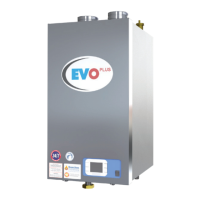26
PART 4. VENTING
3. If practical, close all building
doors, windows and all doors
between the space in which the
appliance remains connected
to the common venting system
and other spaces in the building.
Turn on clothes dryers and any
appliances not connected to the
common venting system. Turn on
any exhaust fans, such as range
hoods and bathroom exhausts, at
maximum speed. Do not operate
a summer exhaust fan. Close all
fireplace dampers.
4. Place the appliance being
inspected in operation. Follow
the lighting instructions. Adjust
the thermostat so the appliance
will operate continuously.
5. Test for spillage at the draft hood
relief opening after 5 minutes of
main burner operation. Use the
flame of a match or candle or
smoke from a cigarette.
6. After it has been determined
that each appliance remaining
connected to common venting
system properly vents when
tested as outlined, return
doors, windows, exhaust fans,
fireplace dampers and any other
gas burning appliance to their
previous condition of use.
7. Any improper operation of the
common venting system should
be corrected so the installation
conforms with the National
Fuel Gas Code, ANSI Z223.1.
When resizing any portion of
the common venting system,
the common venting system
should be resized to approach
the minimum size as determined
using the appropriate tables in
Appendix G in the National Fuel
Gas Code, ANSI Z 223.1
F. CONDENSATE REQUIREMENTS
This is a condensing high eciency appliance,
therefore this unit has a condensate removal
system. Condensate is nothing more than water
vapor derived from the combustion products,
similar to an automobile when it is initially
started. This condensate does have a low pH and
should be treated with a Condensate Neutralizer
Filter. This filter contains either lime or marble
rocks, which will neutralize the condensate. The
outlet of the filter is sized for 1.5" PVC pipe. It
is very important that the condensate line
is sloped away from and down to a suitable
inside drain. A condensate neutralizer and a
condensate pump kit are available from Hamilton
Engineering Co, Inc. It is also very important
that the condensate line is not exposed to
freezing temperatures, or any other type of
blockage. Plastic tubing or PVC pipe should be
the only materials used for the condensate line.
Steel, brass, copper or others will be subject to
corrosion and deterioration. A second vent may be necessary to prevent
condensate line vacuum lock if a long horizontal run is used. The EVO
appliance has an automatic safety device that will shut it down in the
event of a condensate drain blockage. Please test annually.
Maximum volume of condensate produced is 11 gallons per hour per
1,000,000 BTU of gas burned.
E. HEATER REMOVAL FROM AN EXISTING COMMON VENT SYSTEM (continued)
NOTE: Heat
exchanger
MUST be level or
pitched slightly
to the rear!
In a common vent system, DO NOT POWER
THE UNIT OFF! Equipment damage may
occur. To disable operation, turn o gas,
NOT power. If you have any questions,
please call Hamilton Engineering Technical
Support at 800.968.5530.
WARNING
FIGURE 47
CONDENSATE DRAIN DETAIL

